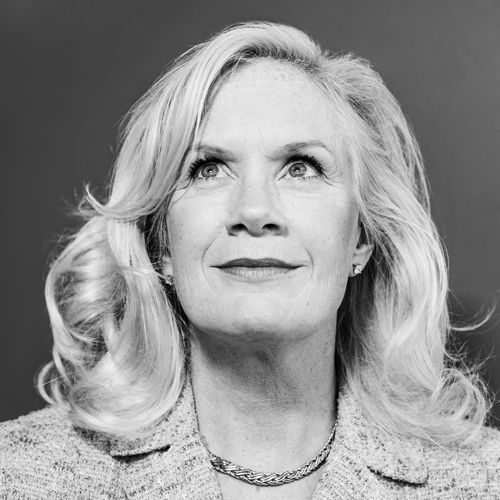Meg Newman wants you to have as much time on Earth as possible: time for loved ones, meaningful work, and donuts—in moderation.
Driven by a desire to make meaningful contributions, Newman explored social work and psychology before arriving in the human resources world. Her work in employee health and wellness—driving engagement, lowering costs, and applying data analytics—has rewarded that impulse, and she looks forward to making an impact as chief human resources officer at Keurig Green Mountain, which she joined in 2017.
In 2007, Newman joined HD Supply, an industrial distributor headquartered in Atlanta. After reviewing employee benefits, costs to the organization, and comparisons to national averages, she recognized areas in which she could improve employee wellness and reduce claims costs to the organization. To encourage engagement and generate momentum, she created a “Wellness Roadshow” to tour to HD workplaces across the country. The third session, held in Dallas, revealed the power of the personal element and the project’s potential to create lasting changes across the organization.
“We were in front of about one hundred people, going through our overview,” Newman recalls. “I’d just had a personal loss in my family, somebody who maybe didn’t take care of himself as well as he could have. It was very fresh. I shared this story with the team and said, ‘Look: all this matters. There are costs and benefits, but what’s really important to me is that you’re here as long as you can be, in the best shape possible, to spend time with the people who matter most to you.’”
As she finished her story, hands shot up around the room, and those associates related similar stories of their own. After the meeting, Newman turned to a colleague and said, “We never have to send out another stock photo in our benefits brochures. It’ll always be an associate’s face.”
Gathering the associates’ voices and stories became a crucial component of the Wellness Roadshow, and by using storytelling and data to support each other, Newman and her team guided the organization to substantial progress on a number of wellness metrics. While their initial survey revealed that 30 percent of the workforce were regularly using tobacco products, Newman’s efforts over five years reduced that rate to 7 percent. In addition, the rate at which employees got their annual physicals rose from 13 to 87 percent.
Physicals had been a particularly challenging issue. Early efforts to increase engagement gained some traction, but Newman recalls the moment that someone finally said that HR would just have to make the appointments mandatory. They did, and that rate quickly leapt close to their target number. Plus, she notes, there was no adverse effect on the employment relationship.
“Employers have a responsibility to provide good programs and tools. Associates then have to do what they have to do to utilize those tools and stay healthy,” she says.
After ten years at HD Supply, Newman had the opportunity to implement that principle at Keurig. When she joined the organization in March of 2017, she noticed that data analytics were not yet a strong element of that HR institution. So, she set about implementing such a program to guide their work going forward. Over time, she’ll be using data to develop and influence Keurig’s company culture and affirm the organization’s commitment to employee wellness.
“There are costs and benefits, but what’s really important to me is that you’re here as long as you can be, in the best shape possible, to spend time with the people who matter most to you.”
Claims costs, productivity, turnover rates, and other useful information may be buried across a number of databases and files, but they reveal important trends most clearly in synthesis. For Newman, the foundation of an effective data analytics approach is a system that can gather disparate data into a central interface for user query. “You have to have a good tool,” she explains. “You need systems that feed into each other and a good HR technology road map. We have good systems. We need to add a couple, and then it’ll be easy for our people to work with. Part of it is pulling the data, and the other part of it is telling the story, so those are the areas that we focus on.”
The HR and technology teams are crafting an approach that uses data and technology to track trends and answer an array of questions about the state of Keurig. Leaders forward to the moment that some answers come to fruition, at which point they can conduct a substantive conversation about what’s going on in each sector.
Newman takes care to emphasize that data analytics is not a discrete project. Instead, it’s a holistic evolution of perspective and process, leading to a healthier, more rational organization. Just as a gym membership doesn’t itself constitute a lifestyle change, a data analytics infrastructure isn’t an enterprise utility until HR can successfully call upon it to develop and influence company culture. “I consider it a way of life,” Newman explains. “Having a talent analytics crew is as critical as having a recruitment or staffing organization. To me, there’s no beginning and no end; it will continue to go on.”
The journey of wellness and analytics has been transformative not only for her organizations, but for Newman herself. Once the person who would buy the office pizza on Fridays, she says she’s now more thoughtful and intentional with her choices—as a leader, a colleague, and an individual.
“At HD they used to call me the donut police,” she says. “I don’t care if you have a donut—everything in moderation—but we should think about what we introduce into our environments.” Although she didn’t have a specific interest in wellness and well-being at the beginning of her career, Newman is grateful to have had the opportunity. Her career path has allowed her to empower her associates and grow as a professional. That growth has resonated in Newman’s personal choices, leadership, and understanding of the importance of storytelling, and she’s excited at this unique opportunity to do more good at Keurig.
“I’ve always considered myself a good listener, but my work has really amplified taking the time to understand what’s going on with people, sharing stories, and listening,” Newman says. “I’m thinking about the effects of everything that we do on a daily basis.”















